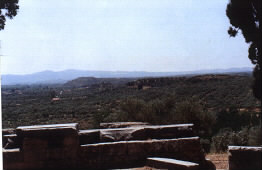


Book Summary (Pg. 2)
In Laconia they worship Potnia
and a very ancient shrine contains her form hewn from an olive tree,
blackened with time. I see it as a sculpture by Jean Arp, so smooth and
worn with age it has become an abstract suggestion of hip and breast, its
curves attracting the light from roof openings directed to the niche where
it rests. It is famous. People come from afar to worship and read the marks in the sand below
made by snakes that interpret her messages. This holy form is stolen by
two visiting Kings who have been honored in every way on this festival day
of the summer solstice. To them it is a prank. They and King Tyndareus,
Helen's father, joke abut how backward Amyklae is.  Isn't it time the
people of the countryside gave up that old relic and paid attention to
Zeus?" These Kings are descendents of invaders several generations back.
Their sky god religion is making deep in- roads everywhere. Yet, it is
still necessary for them to marry goddess priestesses to attain kingship,
a custom that also introduced marriage into the goddess society. Formerly
there were ritual celebrations of procreation which were still practiced
in Laconia. It is part of the young priestess's initiation to partake in
this ritual. The summer solstice festival is a time of such a
celebration.
Isn't it time the
people of the countryside gave up that old relic and paid attention to
Zeus?" These Kings are descendents of invaders several generations back.
Their sky god religion is making deep in- roads everywhere. Yet, it is
still necessary for them to marry goddess priestesses to attain kingship,
a custom that also introduced marriage into the goddess society. Formerly
there were ritual celebrations of procreation which were still practiced
in Laconia. It is part of the young priestess's initiation to partake in
this ritual. The summer solstice festival is a time of such a
celebration.
Helen is a priestess to Potnia. This involves study in the temple and learning the practices and lore of the goddess religion. On this day of festivity she won the race of the maidens and was given the honor of protecting the sacred relic. Her effort to retrieve it leads her into an absence from home for nearly a year. It involves being kidnapped by King Theseus, falling in love with Theseus, being held prisoner in a remote fortress, discovering she is pregnant, rescued by brothers, ship wrecked on return, baring child, finding haven with sister in Mycenae, and finally returning with the effigy to Amyklae, but to her constant remorse and anger, without her child.